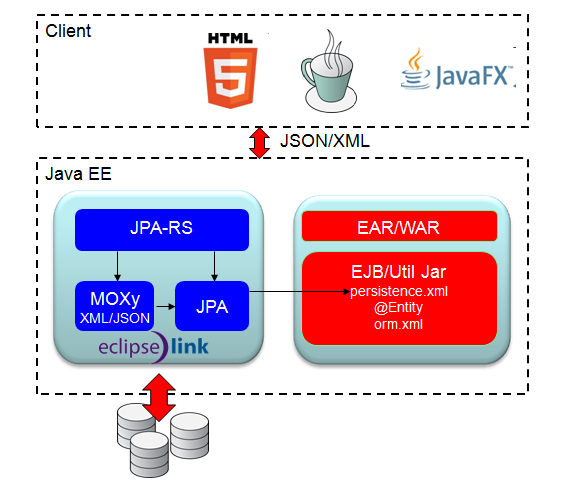Notice: this Wiki will be going read only early in 2024 and edits will no longer be possible. Please see: https://gitlab.eclipse.org/eclipsefdn/helpdesk/-/wikis/Wiki-shutdown-plan for the plan.
Difference between revisions of "EclipseLink/Development/2.4.0/JPA-RS"
(→Security) |
(→Configurable Content) |
||
| Line 59: | Line 59: | ||
== Configurable Content == | == Configurable Content == | ||
| − | By default all entity types CRUD operations and named queries will be exposed by JPA-RS. | + | By default all entity types CRUD operations and named queries will be exposed by JPA-RS. Configuration of which URLs are available is through the security policy described above. |
=== Additional URIs === | === Additional URIs === | ||
In addition to the URI's for all defined named queries and entity types there should be support in JPA-RS to access server side application logic within EJB session beans. | In addition to the URI's for all defined named queries and entity types there should be support in JPA-RS to access server side application logic within EJB session beans. | ||
Revision as of 15:32, 16 March 2012
Contents
EclipseLink JPA-RS
bug 362900 The EclipseLink 2.4.0 release will include an easy to use RESTful interface for interacting with JPA persistence units and EJB session bean methods. The intent is to provide an easy to use solution for exposing these Java EE capabilities through REST.
Key Features
- Simple Enablement: The JPA-RS capability can be easily added to any Java EE application being deployed to any compliant Java EE server by simply adding JPA-RS components to an application.
- Zero configuration: When enabled the exposed JAX-RS service will allow any persistence unit or related EJB to be accessed using simple REST calls. Optional configuration will be supported for developers who want to limit what capabilities are exposed or wish to customize the resources used in any REST operation.
- Dynamic JPA-RS: Enable the deployment of a generic JPA-RS application into a compliant Java EE server without requiring any included persistence units. This dynamic service will support provisioning of persistence units on the fly by passing in or providing reference to dynamic JPA configuration XML (persistence.xml and eclipselink-orm.xml using virtual entities).
Requirements
RESTFul API
When enabled JPA-RS will expose the complete capabilities of the persistence units defined within the application.
EclipseLink/Development/2.4.0/JPA-RS/REST-API
Persistence Unit Access
In order for JPA-RS to access a persistence unit it must be made available through one of the following mechanisms:
- Available on classpath of running JPA-RS instance so standard JPA bootstrapping can find it
- Provisioned: This requires a PUT call to the service to inform it of a PU
- Pass in all of the configuration
- Pass in minimal information with information about where to retrieve additional config from
Using JPA-RS with static PU
The goal is to make enabling of JPA-RS as easy to do as possible.
JAX-RS
In order to function in standard JAX-RS solution there must be annotated classes in the deployed WAR.
Jersey
The JAX-RS reference implementation is Jersey (jersey.java.net). Additional support will be added to leverage Jersey's (add version) planned support for defining JAX-RS applications and resources using their API. The goal here is to allow JPA-RS to be declaratively configured without requiring any additional code to be included in a user's WAR/EAR.
Dynamic JPA-RS
Dynamic JPA-RS refers to the notion of a JPA-RS application deployment where persistence unit definitions are installed/provisioned on the fly.
Security
There will be no security implemented with JPA-RS. Users wishing to secure their JPA-RS access should follow standard RESTful securing practices.
The REST URLs described in the document linked above give an idea of which URLs could be restricted using a standard user/role based system. Some things to consider:
- Simple CRUD operations are available at: <base>/{unit-name}/entity/{type}. Reads are GETs, and writes use PUT/POST/DELETE.
- Queries can also Read, Update and Delete: <base>/{unit-name}/query/<queryName>. You will likely want similar restrictions on queries as other CRUD operations. Reads are GETs and writing queries are POST
- Single result read queries are at: GET /persistence/{unit-name}/querySingleResult/{name} and should likely be treated like other Read queries
- Bootstrapping operations should likely be secured as they allow dynamic addition of mappings and persistence units. PUT/DELETE /persistence/{unit-name}
- Metadata is available by Rest and may need securing: GET /persistence and GET /persistence/unitName
Configurable Content
By default all entity types CRUD operations and named queries will be exposed by JPA-RS. Configuration of which URLs are available is through the security policy described above.
Additional URIs
In addition to the URI's for all defined named queries and entity types there should be support in JPA-RS to access server side application logic within EJB session beans.

